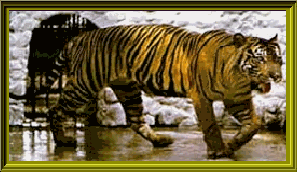|
CASPIAN TIGER
The Caspian tiger (Panthera tigris virgata) once roamed the forests of Afghanistan, Turkey, Iran, Mongolia, and the Asiatic region of Russia. Not unlike their Bengal cousins, the female Caspians measured between 241cm to 259cm and weighing approximately 84kg to 135kg, while males were 264cm to 294cm in length and 169kg to 239kg in weight. They were known to the local people as the "travelling leopard" because of their habit of following wild pigs and reindeer, which appeared to be its primary prey. Like the Bengal race, Caspians had black stripes on their shoulders, their necks and the outer parts of their limbs. Deforestation and agricultural development forced the sub-species into regions they wouldn't normally inhabit, and with traps also laid by locals to help prevent tigers from attacking domestic livestock, these factors therefore contributed to the loss of this rare species of tiger. Despite many searches no traces have been found of this sub-species. Declining since the 1930s, it was declared extinct in 1980, although the last known Caspian tiger was killed in 1970 in Turkey.
|
|








